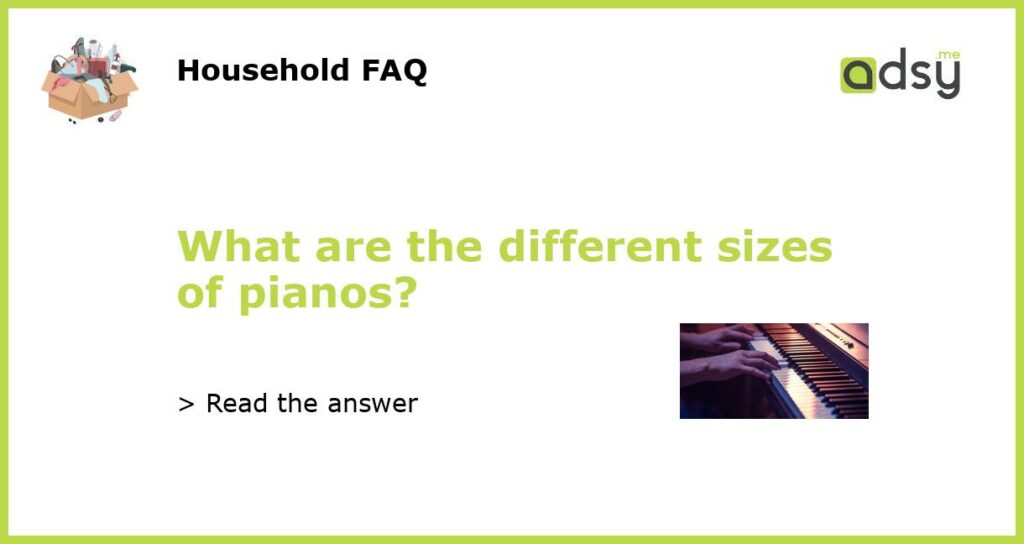The Different Sizes of Pianos Explained
When it comes to pianos, there are several different sizes available, each with its own unique characteristics. Whether you are a beginner pianist or an experienced player, it is important to understand the different sizes to make an informed decision. In this article, we will break down the various sizes of pianos and their features.
Grand Pianos
Grand pianos are known for their impressive size and elegant shape. They are often the centerpiece of a room and can range in size from 5 feet all the way up to 9 feet or more. The larger the grand piano, the longer the strings and the greater the soundboard area, resulting in a richer and more resonant sound.
The smallest grand pianos, known as baby grands, typically measure around 5 to 6 feet in length. They are suitable for smaller spaces and are often chosen for homes or recording studios. As the size of the grand piano increases, so does the depth and power of the sound. Concert grand pianos, which can be over 9 feet long, are the largest and produce the most dramatic and robust sound.
Upright Pianos
Unlike grand pianos, upright pianos have a more vertical structure. They are designed to save space and are often preferred for home use. Upright pianos come in various sizes, typically ranging from 36 inches to 52 inches tall. The height of the piano directly corresponds to the length of the strings and the size of the soundboard, which affects the tonal quality.
Shorter upright pianos, also known as spinets, consoles, or studio pianos, are around 36 to 40 inches tall. They are compact and suitable for smaller rooms, making them popular choices for beginners or casual players. Taller upright pianos, such as upright grands or professional uprights, can reach heights of 48 to 52 inches and offer a more powerful and resonant sound.
Digital Pianos
Digital pianos are designed to replicate the sound and feel of an acoustic piano while offering modern features and convenience. They come in various sizes and styles, ranging from compact portable models to full-size electric pianos. The size of a digital piano often depends on its intended use and portability.
Compact digital pianos are typically lightweight and portable, making them suitable for musicians on the go or those with limited space. They usually have smaller keyboards and fewer built-in features. Full-size digital pianos, on the other hand, are designed to resemble the size and feel of an acoustic piano. They often have weighted keys and offer a wide range of sounds and functions.
Specialty Pianos
In addition to the standard grand, upright, and digital pianos, there are also specialty pianos that cater to specific needs and preferences. These include but are not limited to:
- Square Pianos: Smaller pianos with a square-shaped design that was popular in the 18th and 19th centuries.
- Electronic Pianos: Pianos that use electronic sound synthesis to produce piano sounds and offer various features.
- Player Pianos: Pianos that can play music automatically with the help of perforated paper rolls or digital controls.
- Harpsichords: Keyboard instruments that produce sound by plucking strings, popular during the Baroque era.
These specialty pianos come in various sizes and offer unique sounds and playing experiences, catering to different musical styles and preferences.
Considerations for Choosing the Right Size
When choosing a piano, it is essential to consider factors such as available space, playing level, and musical goals. Here are a few considerations to keep in mind:
- Room size: Ensure that the piano you choose fits comfortably in your space without overwhelming the room.
- Sound quality: Larger pianos generally produce a more powerful and resonant sound, but the size may not be necessary for everyone.
- Budget: Larger pianos tend to be more expensive, so consider your budget and the value you place on the sound and playing experience.
- Playing level: Beginners may find smaller pianos or digital pianos more suitable, while professional pianists may prefer the sound and touch of a grand piano.
Ultimately, the size of the piano is a personal preference and should be chosen based on individual needs and musical aspirations.






